King's Cross railway station, also known as London King's Cross, is a passenger railway terminus in the London Borough of Camden, on the edge of Central London. It is in the London station group, one of the busiest stations in the United Kingdom and the southern terminus of the East Coast Main Line to Yorkshire and the Humber, North East England and Scotland. Adjacent to King's Cross station is St Pancras International, the London terminus for Eurostar services to continental Europe. Beneath both main line stations is King's Cross St Pancras tube station on the London Underground; combined, they form one of the country's largest and busiest transport hubs.
The station was opened in Kings Cross in 1852 by the Great Northern Railway on the northern edge of Central London to accommodate the East Coast Main Line. It quickly grew to cater to suburban lines and was expanded several times in the 19th century. It came under the ownership ...Read more
King's Cross railway station, also known as London King's Cross, is a passenger railway terminus in the London Borough of Camden, on the edge of Central London. It is in the London station group, one of the busiest stations in the United Kingdom and the southern terminus of the East Coast Main Line to Yorkshire and the Humber, North East England and Scotland. Adjacent to King's Cross station is St Pancras International, the London terminus for Eurostar services to continental Europe. Beneath both main line stations is King's Cross St Pancras tube station on the London Underground; combined, they form one of the country's largest and busiest transport hubs.
The station was opened in Kings Cross in 1852 by the Great Northern Railway on the northern edge of Central London to accommodate the East Coast Main Line. It quickly grew to cater to suburban lines and was expanded several times in the 19th century. It came under the ownership of the London and North Eastern Railway as part of the Big Four grouping in 1923, who introduced famous services such as the Flying Scotsman and locomotives such as Mallard. The station complex was redeveloped in the 1970s, simplifying the layout and providing electric suburban services, and it became a major terminus for the high-speed InterCity 125. As of 2018, long-distance trains from King's Cross are run by London North Eastern Railway to Edinburgh Waverley, Leeds and Newcastle; other long-distance operators include Hull Trains and Grand Central. In addition, Great Northern runs suburban commuter trains around North London, Hertfordshire, Cambridgeshire and Norfolk.
In the late 20th century, the area around the station became known for its seedy and downmarket character, and was used as a backdrop for several films as a result. A major redevelopment was undertaken in the 21st century, including restoration of the original roof, and the station became well known for its association with the Harry Potter books and films, particularly the fictional Platform 9+3⁄4.
The area of King's Cross was previously a village known as Battle Bridge which was an ancient crossing of the River Fleet, originally known as Broad Ford, later Bradford Bridge. The river flowed along what is now the west side of Pancras Road until it was rerouted underground in 1825.[1] The name "Battle Bridge" is linked to tradition that this was the site of a major battle between the Romans and the Celtic British Iceni tribe led by Boudica. According to folklore, King's Cross is the site of Boudica's final battle and some sources say she is buried under one of the platforms.[2] Platforms 9 and 10 have been suggested as possible sites.[2][3] Boudica's ghost is also reported to haunt passages under the station, around platforms 8–10.[4]
Great Northern Railway (1850–1923) King's Cross in 1852
King's Cross in 1852King's Cross station was built in 1851–52 as the London terminus of the Great Northern Railway (GNR), and was the fifth London terminal to be constructed.[5] It replaced a temporary station next to Maiden Lane (now York Way) that had been quickly constructed with the line's arrival in London in 1850,[6] and had opened on 7 August 1850.[7]
The station took its name from the King's Cross building, a monument to King George IV that stood in the area and was demolished in 1845.[8] Construction was on the site of a smallpox hospital.
Plans for the station were made in December 1848 under the direction of George Turnbull, resident engineer for constructing the first 20 miles (32 km) of the Great Northern Railway out of London.[9][10] The station's detailed design was by Lewis Cubitt, the brother of Thomas Cubitt (the architect of Bloomsbury, Belgravia and Osborne House), and Sir William Cubitt (who was chief engineer of the Crystal Palace built in 1851, and consulting engineer to the Great Northern and South Eastern Railways). The design comprised two great arched train sheds, with a brick structure at the south end designed to reflect the arches behind.[11] Its main feature was a 112-foot (34 m) high clock tower that held treble, tenor and bass bells, the last of these weighing 1 ton 9 cwt (1.47 tonnes).[12] In size, it was inspired by the 200 yards (180 m) long Moscow Riding Academy of 1825,[13] leading to its built length of 268 yards (245 m).[5][a]
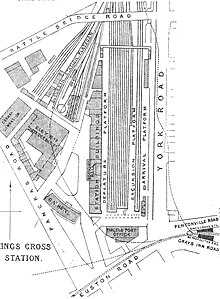 Plan of King's Cross in 1888. Originally there was only one arrival and one departure platform.
Plan of King's Cross in 1888. Originally there was only one arrival and one departure platform.The station, the biggest in England, opened on 14 October 1852.[5] Originally it had one arrival and one departure platform (today's platforms 1 and 8), and the space between was used for carriage sidings.[6] The platforms have been reconfigured several times. They were numbered 1 to 8 in 1972.[14] In 2010 the station was reconfigured again and now has 12 platforms numbered 0 - 11.[15] Suburban traffic quickly grew with the opening of stations at Hornsey in 1850, Holloway Road in 1856, Wood Green in 1859 and Seven Sisters Road (now Finsbury Park) in 1861. Midland Railway services to Leicester via Hitchin and Bedford began running from King's Cross on 1 February 1858.[16] More platforms were added in 1862: No. 2 was full-length, but No. 3 was stepped into the northern end of the station.[17] In 1866, a connection was made via the Metropolitan Railway to the London, Chatham and Dover Railway at Farringdon, with goods and passenger services to South London via Herne Hill.[18] A separate suburban station to the west of the main building, housing platforms 9–11 as of 1972[update] and known initially as "Kings Cross Main Line (Local) Station", opened in August 1875. It was followed by a connection to the Metropolitan line on 1 February 1878.[19] Two platforms (now 5 and 6) were opened on 18 December 1893 to cater for increased traffic demands. An iron footbridge was built halfway down the train shed to connect all the platforms.[20] By 1880, half the traffic at King's Cross was suburban.[21]
A significant bottleneck in the early years of operations was at Gas Works tunnel underneath the Regent's Canal immediately to the north of the station, which was built with a single up track and a single down track. Commercial traffic was further impeded by having to cross over on-level running lines to reach the goods yard.[18] Grade separation of goods traffic was achieved by constructing the skew bridge that opened in August 1877, and the second and third Gas Works tunnels opened in 1878 and 1892 respectively.[22]
On 15 September 1881, a light engine and a coal train collided near the mouth of the Copenhagen Tunnel north of the station because of a signalman's error. One person was killed and another was severely injured.[23] Bad weather contributed to occasional flooding in the tunnels. One such incident in July 1901 suspended all traffic from the station for more than four hours, which happened at no other London terminus.[24]
King's Cross sustained no damage during World War I even though large amounts of high explosives were carried to the station in passenger trains during the war. When possible, trains were parked in tunnels in the event of enemy aircraft overhead.[25]
London and North Eastern Railway (1923–1948)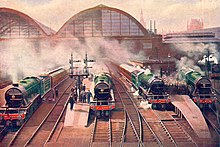 Steam trains at King's Cross in 1928
Steam trains at King's Cross in 1928Kings Cross came into the ownership of the London and North Eastern Railway (LNER) following the Railways Act 1921. The LNER made improvements to various amenities, including toilets and dressing rooms underneath what is now platform 8.[26] The lines through the Gas Works tunnels were remodelled between 1922 and 1924 and improved signalling made it easier to manage the increasing number of local trains.[27]
A number of famous trains have been associated with King's Cross, such as the Flying Scotsman service to Edinburgh.[28] The Gresley A3 and later streamlined A4 Pacific steam locomotives handled express services from the 1930s until 1966.[29] The most famous of these was Mallard, which holds the world speed record for steam locomotives at 126 miles per hour (203 km/h), set in 1938.[30]
King's Cross handled large numbers of troops alongside civilian traffic during World War II. Engine shortages meant that up to 2,000 people had to be accommodated on each train. In the early hours of Sunday 11 May 1941, two 1,000 pounds (450 kg) bombs fell on the, then, platform 10 at the west side of the station, damaging a newspaper train in that platform and destroying the general offices, booking hall and a bar, and bringing down a large section of roof. Twelve people were killed.[31]
On 4 February 1945, a passenger train to Leeds and Bradford stalled in Gasworks Tunnel, ran back and was derailed in the station. Two people were killed and 25 were injured. Services were not fully restored until 23 February.[32][33]
British Rail (1948–1996) Train headed by a Class 55 'Deltic' locomotive at King's Cross platform 5 in 1978. These were the principal express locomotives on the East Coast Main Line in the 1960s and 1970s.
Train headed by a Class 55 'Deltic' locomotive at King's Cross platform 5 in 1978. These were the principal express locomotives on the East Coast Main Line in the 1960s and 1970s.Following nationalisation on 1 January 1948, King's Cross came under the management of British Railways' Eastern Region. Diesel services were introduced during the 1950s when steam was being phased out. All main line services were converted to diesel by June 1963.[31] Platform numbers were reorganised in 1972, to run consecutively from 1 (east) to 14 (west). The track layout was simplified in the 1970s by reusing an old flyover for freight near the Copenhagen Tunnels at Holloway, and reducing the number of running lines through the Gas Works tunnels from six to four. At the same time, electrification started with the installation of a 25 kV overhead line to cater for suburban services as part of the Great Northern Suburban Electrification project.[34] The works were completed on 3 April 1977, and electric services began running from King's Cross to Hertford, Welwyn Garden City and Royston[35][36]
The construction of the Victoria line and its interchange at King's Cross was seen by British Rail as an opportunity to modernise the station.[37] A single-storey extension containing the main passenger concourse and ticket office, designed in-house, was built at the front of the station in 1972. Although intended to be temporary, it was still standing 40 years later, obscuring the Grade I-listed façade of the original station.[38] Before the extension was built, the façade was hidden behind a small terrace of shops. The extension was demolished in late 2012,[39] revealing the Lewis Cubitt architecture. In its place, the 75,000-square-foot (7,000 m2) King's Cross Square was created, and opened to the public on 26 September 2013.[40]
On 10 September 1973, a Provisional IRA bomb exploded in the booking hall at 12.24 p.m., causing extensive damage and injuring six people, some seriously. The 3 lb (1.4 kg) device was thrown without warning by a youth who escaped into the crowd and was not caught.[41]
King's Cross was a London terminus for InterCity 125 high speed services, along with Paddington. By 1982, almost all long-distance trains leaving King's Cross were 125s. The service proved to be popular, and the station saw regular queues across the concourse to board departing trains.[42]
The King's Cross fire in 1987 started in the machine room for a wooden escalator between the main line station and the London Underground station's Piccadilly line platforms. The escalator burned and much of the tube station caught fire, killing 31 people, with smoke spreading to the main line station.[43]
In 1987, British Rail proposed building a new station with four platforms for international trains through the Channel Tunnel, and four for Thameslink trains under King's Cross. After six years of design work, the plans were abandoned, and the international terminal was constructed at St Pancras.[21]
British Rail completed electrification of the East Coast Main Line to Leeds and Edinburgh between 1985 and 1991, and electric InterCity 225 rolling stock was introduced to work express services. These began service between King's Cross and Leeds on 2 October 1989, and to Edinburgh on 8 July 1991.[44][45]
Privatisation (1996–present)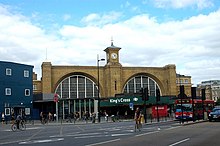 The former concourse seen in 2008
The former concourse seen in 2008Before privatisation, the King's Cross area had a reputation for run-down buildings and prostitution in front of the main entrance. There was a major clean-up during the 1990s and the station's atmosphere was much improved by the end of the decade.[21]
Following the privatisation of British Rail in 1996, express services into the station were taken over by the Great North Eastern Railway (GNER). The company refurbished the British Rail Mark 4 "Mallard" rolling stock used for long-distance services from King's Cross and the inauguration of the new-look trains took place in the presence of the Queen and the Duke of Edinburgh in 2003.[46]
GNER successfully re-bid for the franchise in 2005, but surrendered it in the following year.[47] National Express East Coast took over the franchise in late 2007 after an interim period when trains ran under a management contract.[48] In 2009, it was announced that National Express was no longer willing to finance the East Coast subsidiary, and the franchise was taken back into public ownership and handed over to East Coast in November.[49] In March 2015 the franchise was re-privatised and taken over by Virgin Trains East Coast.[50] In November 2017, Transport Secretary Chris Grayling announced the early termination of the East Coast franchise in 2020, three years ahead of schedule, following losses on the route by the operator. The current provider of ECML services is London North Eastern Railway.[51][52]
Restoration King's Cross following refurbishment in 2012. The steel structure of the roof, engineered by Arup, has been described as being "like some kind of reverse waterfall, a white steel grid that swoops up from the ground and cascades over your head".[53]
King's Cross following refurbishment in 2012. The steel structure of the roof, engineered by Arup, has been described as being "like some kind of reverse waterfall, a white steel grid that swoops up from the ground and cascades over your head".[53]The £500 million restoration plan announced by Network Rail in 2005 was approved by Camden London Borough Council in 2007.[54] It involved restoring and reglazing the original arched train shed roof and removing the 1972 extension at the front of the station and replacing it with an open-air plaza.[53][55]
The new semi-circular departures concourse opened to the public in March 2012.[56][57] Situated to the west of the station behind the Great Northern Hotel, it was designed by John McAslan and built by Taylor Woodrow Construction, part of Vinci.[58] It caters for much-increased passenger flows and provides greater integration between the intercity, suburban and underground sections of the station. The architect claimed that the roof is the longest single-span station structure in Europe and the semi-circular structure has a radius of 59 yards (54 m) and more than 2,000 triangular roof panels, half of which are glass.[53]
 The new concourse seen from above. St Pancras railway station is to the right.
The new concourse seen from above. St Pancras railway station is to the right.Land between and behind Kings Cross and St Pancras stations is being redeveloped as King's Cross Central with around 2,000 new homes, 5,000,000 sq ft (464,500 m2) of offices and new roads.[59] In the restoration, refurbished offices have opened on the east side of the station to replace ones lost on the west side, and a new platform, numbered 0, opened underneath them on 20 May 2010.[60] Diesel trains cannot normally use this platform for environmental reasons.[61] The restoration project was awarded a European Union Prize for Cultural Heritage / Europa Nostra Award in 2013.[62][63]
In October 2021, Lumo commenced operating services to Edinburgh Waverley via Stevenage, Newcastle and Morpeth.[64][65][66]
RemodellingIn January 2018, it was announced that half the station would close for 3 months from January to March 2020 for remodelling work to the station and its approach, expected to cost £237 million. This includes rationalisation of the tracks, reopening the third tunnel to the approach of the station and closure of platform 10.[67][68] In June 2021, Network Rail released a time lapse video showing the completion of the works.[69]
Accidents and incidentsThere have been many accidents at King's Cross over the years. The most serious were the King's Cross railway accident on 4 February 1945 which killed two people and injured 25[32][33] and a collision in Gasworks Tunnel on 15 September 1881 which killed one person and seriously injured another.[23] The most recent was on 17 September 2015 when a passenger train collided with the buffer stops, injuring fourteen people.[70][71]
On 5 November 1979, Martin Allen was seen saying goodbye to his friends at King's Cross. He set off in the direction of the Piccadilly line platform, but he was never seen again.[72] The station is also where Andrew Gosden was last seen before going missing on 14 September 2007. He had caught a train there from Doncaster under controversial and unexplained circumstances.[73]
Cite error: There are <ref group=lower-alpha> tags or {{efn}} templates on this page, but the references will not show without a {{reflist|group=lower-alpha}} template or {{notelist}} template (see the help page).














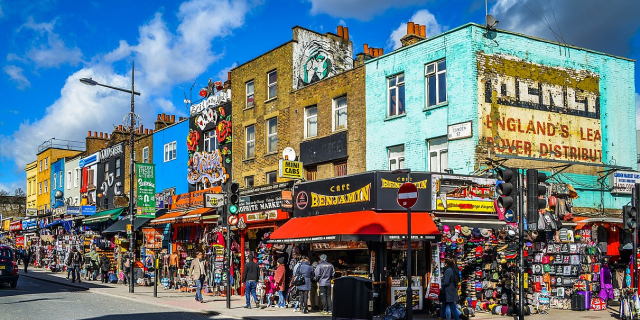





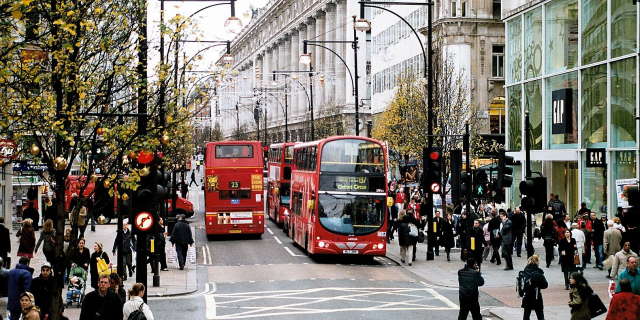















Add new comment